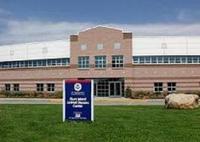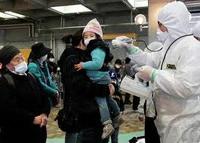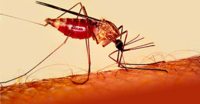-
New rapid diagnostic test for pathogens, contaminants developed
Using nanoscale materials, researchers have developed a single-step method rapidly and accurately to detect viruses, bacteria, and chemical contaminants; the method could be used to detect pathogens and contaminants in biological mixtures such as food, blood, saliva, and urine
-
-
Police officers need sleep for health, performance
Forget bad guys and gunfire: Being a police officer can be hazardous to your health in other ways; a news study found that officers working the evening or night shifts were fourteen times more likely to get less restful sleep than day-shift officers, and also were subjected to more back-to-back shifts, exacerbating their sleep deficit – and that police officers who sleep fewer than six hours per night are more susceptible to a variety of health problems
-
-
Scaled-back Kansas biolab would meet U.S. needs

A report by the National Research Council says that it is “imperative” that the United States build a large-animal biocontainment laboratory to protect animal and public health; two options are acceptable: a $1.4 billion Biosafety Level 4 laboratory in Manhattan, Kansas, or a scaled-back Kansas lab tied to a distributed laboratory network in other facilities; a third option will not meet U.S. needs: maintaining current capabilities at Plum Island Animal Disease Center, because the Plum Island facilities do not meet current standards for high biocontainment
-
-
Calculating the global health consequences of the Fukushima nuclear disaster

Radiation from Japan’s Fukushima Daiichi nuclear disaster may eventually cause approximately 130 deaths and 180 cases of cancer, mostly in Japan; researchers have calculated; the estimates have large uncertainty ranges, but contrast with previous claims that the radioactive release would likely cause no severe health effects
-
-
Sustainability of infectious disease surveillance
Just as the globalization of trade and travel is rapidly evolving, so is the globalization of infectious diseases and the need for cooperative approaches to detect, prevent, and control them
-
-
Genetically engineered bacteria prevent mosquitoes from transmitting malaria

Malaria kills more than 800,000 people worldwide each year, many are children; researchers have genetically modified a bacterium commonly found in the mosquito’s midgut and found that the parasite that causes malaria in people does not survive in mosquitoes carrying the modified bacterium
-
-
Researchers discover a molecule's previously unknown role in fighting off E. coli
Escherichia coli (abbreviated as E. coli) are a large and diverse family of bacteria; most strains of E. coli are harmless, but some can be deadly; E. coli creeps into the food supply through contamination by tiny (usually invisible) amounts of human or animal feces; many people may develop mild symptoms, but some suffer severe complications that can lead to kidney failure and death; researchers discover a molecule’s previously unknown role in fighting off E. coli and other bacterial infections, a discovery that could lead to new ways to protect people from these dangerous microorganisms
-
-
Northrop Grumman's biodetection solution completes field test
Northrop Grumman says its Next Generation Automated Detection System (NG-ADS) for homeland defense applications has successfully completed a field test and is ready for the program’s next phase
-
-
Poultry vaccines found to combine into new viruses
Researchers found that two different vaccine viruses — used simultaneously to control the same condition in chickens — have combined to produce new infectious viruses, prompting early response from Australia’s veterinary medicines regulator
-
-
Environmental changes lead stressed cows in southern U.S. to produce less milk

Researchers found that the decline in milk production due to climate change will vary across the United States, since there are significant differences in humidity and how much the temperature swings between night and day across the country; for instance, the humidity and hot nights make the Southeast the most unfriendly place in the country for dairy cows
-
-
A world free of foot-and-mouth disease within sight
The Departments of Homeland Security and Agriculture have developed a novel vaccine for one of the seven strains of the dreaded foot-and-mouth disease (FMD), paving the way for the development of the others; FMD is one of the most economically devastating diseases in the world for those who raise cows, sheep, pigs, goats, deer, and other cloven-hoofed animals is foot-and-mouth disease
-
-
USDA gives GenVec conditional approval for FMD vaccine for cattle
The USDA has issued a conditional license for GenVec’s foot-and-mouth disease (FMD) vaccine for use in cattle; GenVec’s cell line is capable of producing antigens without the use of the highly contagious FMD virus; because the vaccine is produced without using live or killed virus materials, it can be produced cost effectively in the United States and around the world
-
-
A record: half of U.S. land area is in various stages of drought

Analysis of the latest drought monitor data revealed that 46.84 percent of the U.S. land area is in various stages of drought, up from 42.8 percent a week ago; previous records were 45.87 percent in drought on 26 August 2003, and 45.64 percent on 10 September 2002; looking only at the forty-eight contiguous states, 55.96 percent of the country’s land area is in moderate drought or worse — also the highest percentage on record
-
-
Students and scientists gather in Singapore to discuss water problem
International university students and water experts have converged at Singapore’s Nanyang Technological University (NTU) to foster an intellectual and research community on a scarce natural resource — water
-
-
U.K. potential food crisis
Many climate experts believe a slight rise in U.K. temperatures would be beneficial for the farming industry as yields could increase; as temperatures continue to rise, however, farmers would need to use more and more fertilizer on their crops and some livestock would not be as productive; consumers could thus face reduced food choices
-
More headlines
The long view
Ransomware Attacks: Death Threats, Endangered Patients and Millions of Dollars in Damages
A ransomware attack on Change Healthcare, a company that processes 15 billion health care transactions annually and deals with 1 in 3 patient records in the United States, is continuing to cause massive disruptions nearly three weeks later. The incident, which started on February 21, has been called the “most significant cyberattack on the U.S. health care system” by the American Hospital Association. It is just the latest example of an increasing trend.
